Transit of exoplanet TrES-3b
April 07, 2010
| Frameless version of this page |
Exoplanets and their discovery
Transit of exoplanet TrES-3b, recorded on April 07, 2010 in Nonndorf - Austria
Evaluation and archiving of observation data in the project TRESCA
Exoplanets and their discovery
An extrasolar planet (Exoplanet) is a planet in another solar system. The planet is in an orbit of a different star. Until the year 1990 astronomers only could make science based assumptions about the existence of planets nearby other stars. Till then the proof about the existence of planets also outside of our solar system was not possible even with big telescope systems.
The timing method
In the year 1990 for the first time two planets could be detected nearby a foreign star by the polish astronomer Aleksander Wolszczan by measuring the period change of the beam of the pulsar star PSR 1257+12. But this solar system is not comparable with one like our solar system.
The radial velocity method
The first exoplanet in an orbit of a sun like star was discovered 1995 by Michel Mayor from Departement for Astronomy of the University Geneva and his cooperator Didier Queloz using the radial velocity method. The discovered planet got the designation Pegasi 51b and is in an orbit of the star Pegasi 51 in the constellation Pegasus and about 40 light year away. Using the radial velocity method blue and red shifts of the light because of the Doppler effect are analyzed. This shifts are caused by the movement of the star around a combined centre of gravity.
Within 15 years and until May 18, 2010 overall 455 exoplanets in 388 planet system were detected. The number of planets goes up until five planets per star. In a radius of about 330 light years around us at about 7% of the stars exoplanets could be detected. But because of technical reasons until now only relative big planets could be detected it can be assumed that the percentage of stars with planetes will become much higher in the future.
The transit method
In May 2010 about 80 exoplanets with orbit plane oriented in the direction of Earth are known. So this planets are passing in front of the star disk during an orbit. In this exoplanet systems a data capturing also with the transit method is possible. If a dark planet is passing in front of a bright star disk the overall brightness becomes dimmed a little bit for the transit duration. This event can be captured with an appropriate number of accurate images. For useful results brightness changes caused by the planet transit in the range of 0.27 to 3.7 percent must be captured with accurate times. This images will be evaluated later with adequate and accurate methodes. In this way the transit curve with known tolerances can be generated. From the resulting curve shape the details about the orbit plane and the occultation sequence can be derived.
Further methodes used by professional for confirmation of an exoplanet are microlensing and direct imaging. Although some few amateurs were able to use a selfmade spectrometer system for the radial velocity method the transit method mostly is the only one method that can be realized by amateur astronomers. And in fact some new exoplanets could be detected in this way by amateurs.
The Extrasolar Planets Encyclopaedia
TRESCA Exoplanets Project - with transit data base
The exoplanet system TrES-3
The exoplanet TrES-3b orbits the star with the catalog number GSC 03089-00929 in the constellation Hercules. The exoplanet TrES-3b was officially discovered in the year 2007 by Francis T. O’Donovan with the assistance of 18 furhter astronomers. The exoplanet is somewhat bigger than Jupiter and was discovered over a longer time span with several measurements. On March 26, 2007 a transit of the planet in front of the star could be recorded with a 1.2 meter telescope. Another transit was recorded on April 08, 2007 with a 2.0 meter telescope. Spectral measurements with the 10 meter Keck telescope in Hawai for determination of radial velocity of the centre of gravity showed an amplitude of 378.4 m/s. The orbiting exoplanet pulls the combined centre of gravity during the orbit in a circle. Observed from the Earth one can spectral measure a sinusoidal movement in direction to the Earth and in the opposite direction.
Transit data base - Exoplanet TrES-3b
Data about the star GSC 03089-00929RA (J2000.0) 17h 52m 07.03s DEC (J2000.0) +37° 32´ 46.10" Catalog designation GSC 03089-00929 Distance 1300 light years Brightness V +12.402mag Brightness B-V 0.712mag Brightness V-R 0.417mag Brightness V-I 0.799mag Brightness J +11.015mag Spectral class GV Surface temperature 5720 K Mass 0.924 sun mass Radius 0.813 sun radiiData about the exoplanet TrES-3b Designation TrES-3b Type Hot Jupiter Mass 1.92 Jupiter mass ± 0.081 Radius 1.295 Jupiter radii Orbit radius 0.0226 AU Inclination 82.15 degree Orbital period 1.30619 days ±0.00001 Exccentricity 0 Transit dur. 0.05375 days (77.4 minutes) Transit depth 0.029 mag |
The exoplanet system TrES-3 (simplified)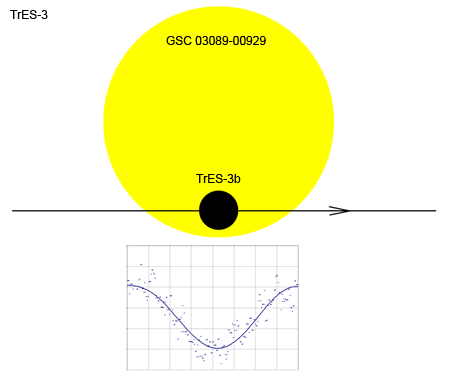
|
Transit of exoplanet TrES-3b, recorded on April 07, 2010 in Nonndorf
The star with the catalog designation GSC 03089-00929 is in comparison to other exoplanet systems in a relative big distance of 1300 light years. With a visual brightness of +12.4 mag this foreign sun is to faint by a factor of about 1.000 for the unaided human eye. Even in normal binocculars this star would stay hidden. This already faint star light will be dimmed by at most 2.7% during the transit of the exoplanet TrES-3b with a disk diameter of about 17% of the star disk diameter. The transit event lasts for about 77.4 minutes and has to be captured with many single timed image frames with good quality for measurement.
Star map with position of TrES-3
The recorded data - overall 326 CCD images
Setup for exoplanet transit recording
CCD image of TrES-3b and comparison stars
Photometric evaluation of the CCD images
Photometric evaluation with MPO software Canopus
Data file exoplanet transit
Graphical diagram of data and determination of the transit maximum with light curve analyze software Peranso 2.40 from Tonny Vanmunster.
The almost V-shaped curve without a flat bottom range is caused by the circumstance that the exoplanet was moving always very near to the edge of the star during the transit.
Evaluation and archiving of observation data in the project TRESCA
After the own photometric evaluation of the measurement images, the data of an exoplanet transit can be sent also to the project TRESCA of "Variable Star and Exoplanet Section of Czech Astronomical Society". The measurement data will be checked there, evaluated and archived in an open access data base.
My measurement data from April 07, 2010 also was sent to the project TRESCA and evaluated there. The archived results can be found here direct under the following link.
Exoplanet TrES-3b transit - 2010/04/07
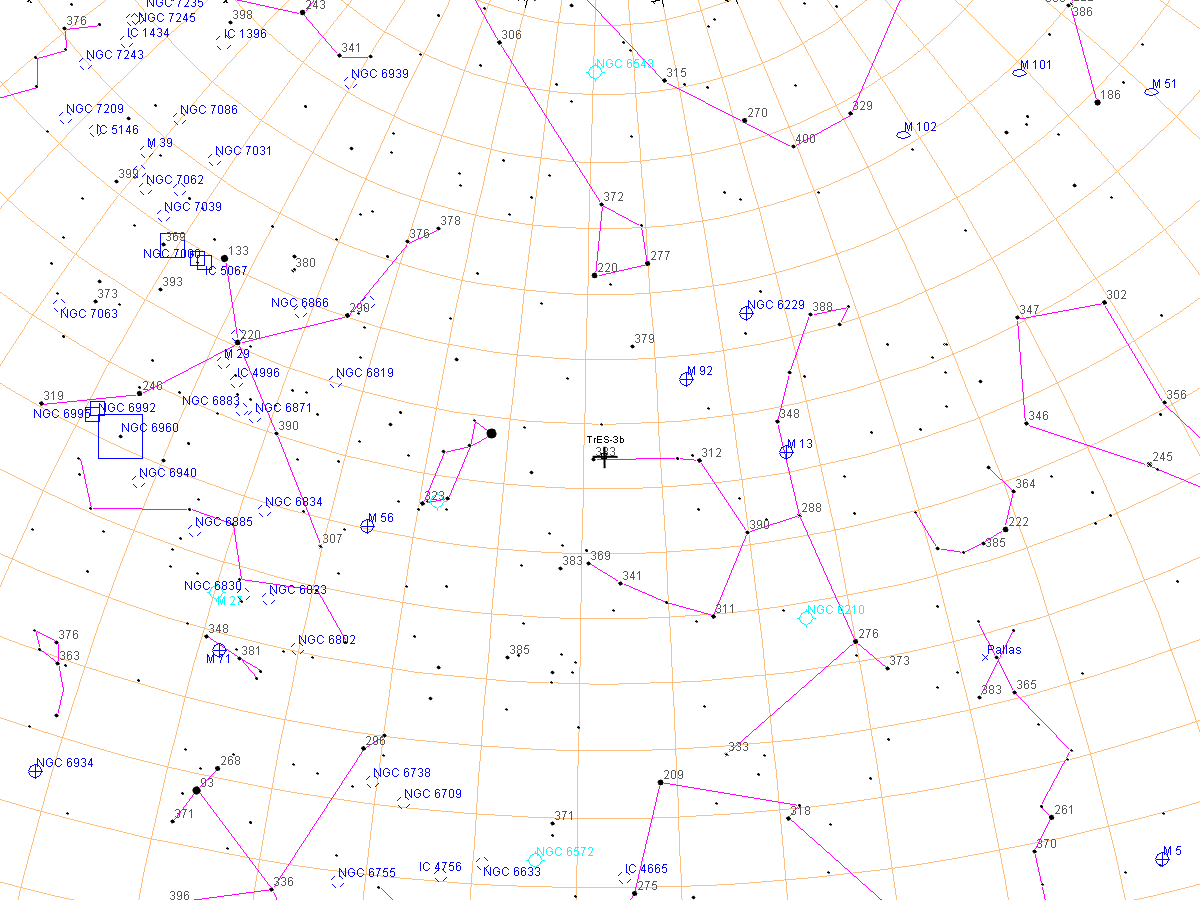
Star map created with Guide 8 from Bill J Gray.
The location of the telescope during data capturing was in Nonndorf at position 15.23563° East, 48.78707° North and 547 MSL. In the time span from April 06, 2010 23:57:45 until April 07, 2010 02:51:12 UTC overall 326 CCD images each with 30 seconds exposure time were captured and stored. During this 10.413 seconds the temperature was rising from -2°C up to 0°C. With an average download time of 1.94s per CCD image a light collecting time of 9.780s or 94% was achieved. All images were made with the CCD camera Atik 314L+ (B/W) in full format 1391x1039 and with binning 1x1. The temperature of the CCD was set to -20°C (253K). The CCD camera control was done with software Artemis from Atik. Used filter was an Astronomik luminance filter with a transmission of 95% in the range from 380nm to 680nm. For off axis guiding of the mount EQ6 the integrating video camera WAT-120N was used. Mount control with Guide8 and EQMOD. Guiding with Guidemaster. The optical system was a 10-inch Newton 1200/254mm with Baader Multi Purpose Coma Corrector - MPCC to flatten the image area.
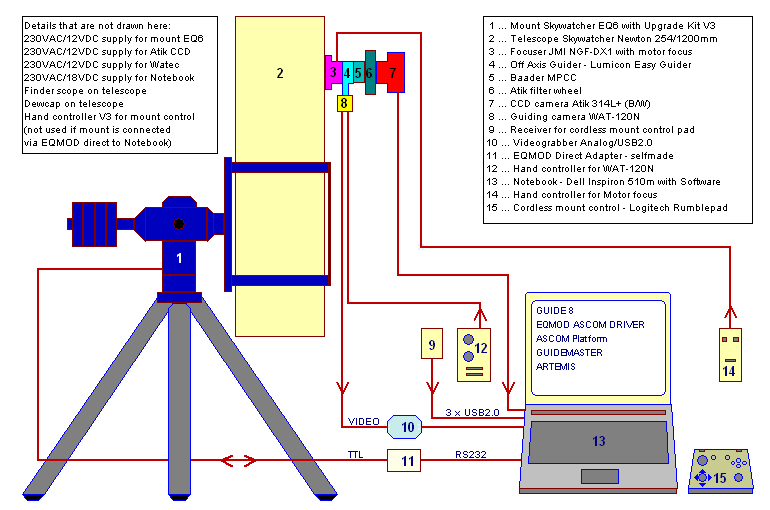
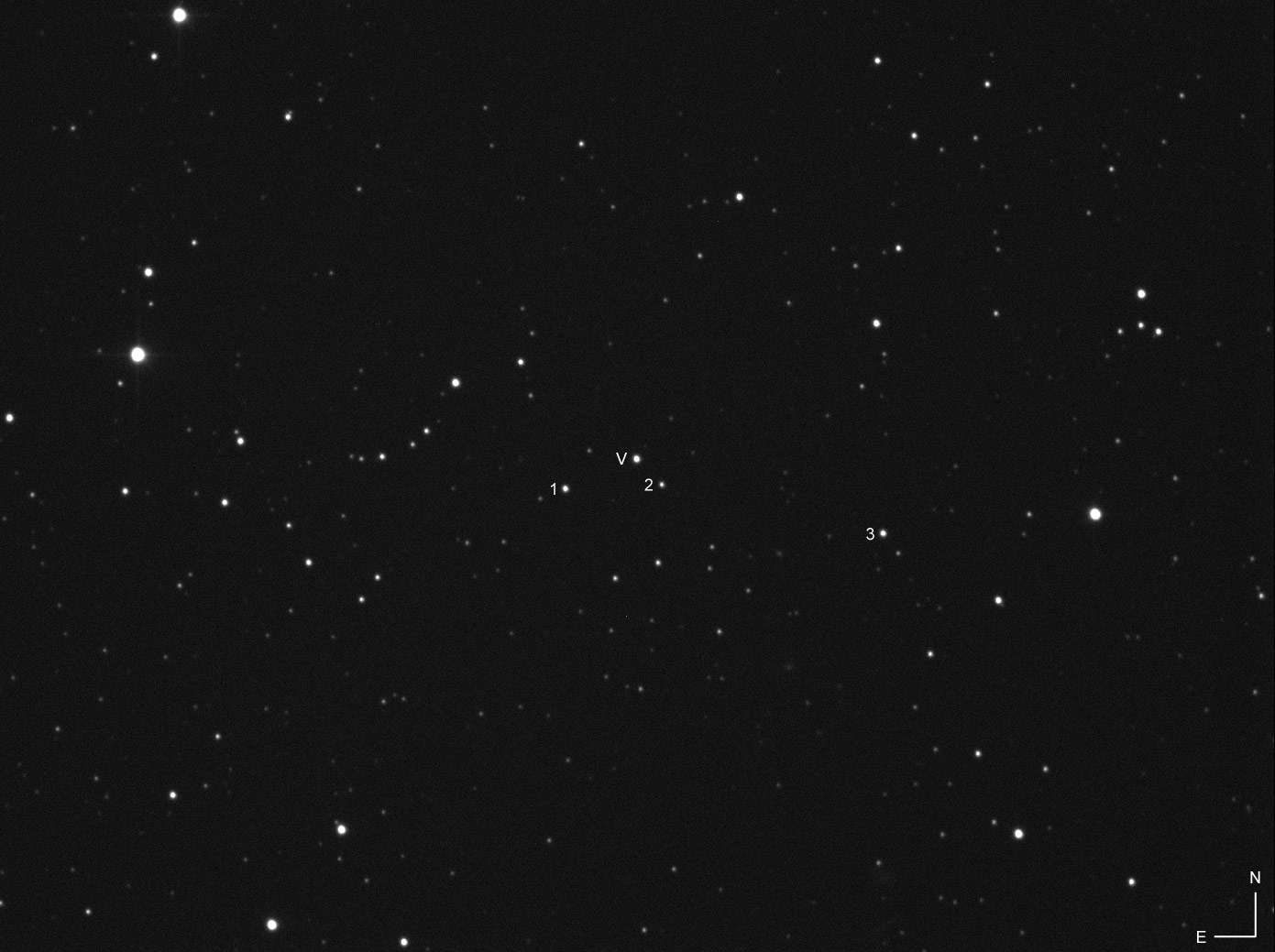
CCD Atik 314L+, Astronomik luminance filter 380nm - 680nm at 95%, 1x30s, Newton 1200/254mm, 1.11arcsec/pixel, FOV 25.7 x 19.2 arcmin
The V labeled exoplanet system TrES-3 (+12.4mag) and the used compare stars numbered with 1, 2 and 3.
The photometric evaluation of the CCD images was done with the MPO software Canopus Version 10 from Brian D. Warner. Therefore first all images were corrected with additional captured dark field and flat field images. The dark field image was used from a dark image library exposured some weeks ago. Flat field images were exposured using a EL foil 297x420mm after the transit. In consideration of before defined parameters in several working steps the photometric data was evaluated with the MPO software. From overall 326 CCD images I have excluded four CCD images (00:24:20 - 00:26:28 UTC) because of guiding errors caused by too strong wind gusts. The amplitude values for the brightness curve are given in relative values and in magnitudes. The corresponding time values were taken direct from the FITS headers and recalculated in heliocentric Julian dates. The correction factor is calculated by the sky coordinates of the object, the date and the observation time. For this observation the value is 0.00098 JD or 84.7 seconds. With the specification of heliocentric times observations made at different times can be combined because the different light running times of the signal to the Earth are compensated. Without such a correction time errors up to 16.62 minutes could occur. This corresponds to the light running time for a distance of two astronomical units (AU) or 299.2 million kilometers.
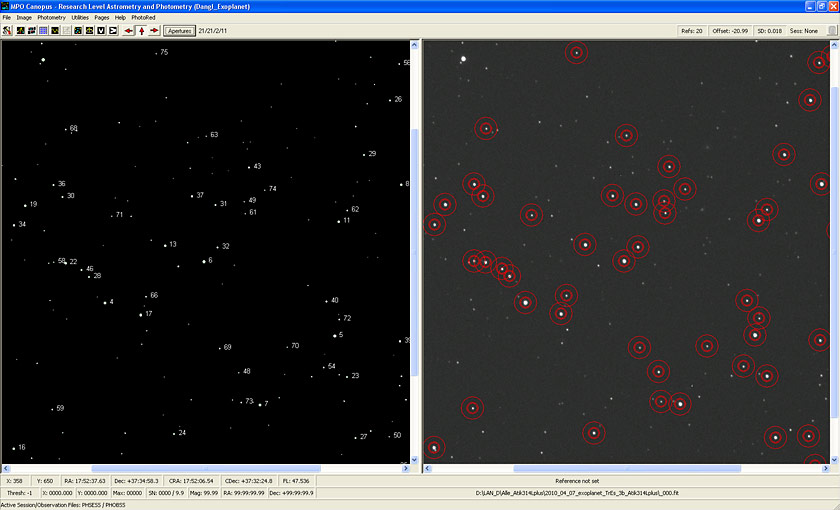
TrES-3b on April,07 2010
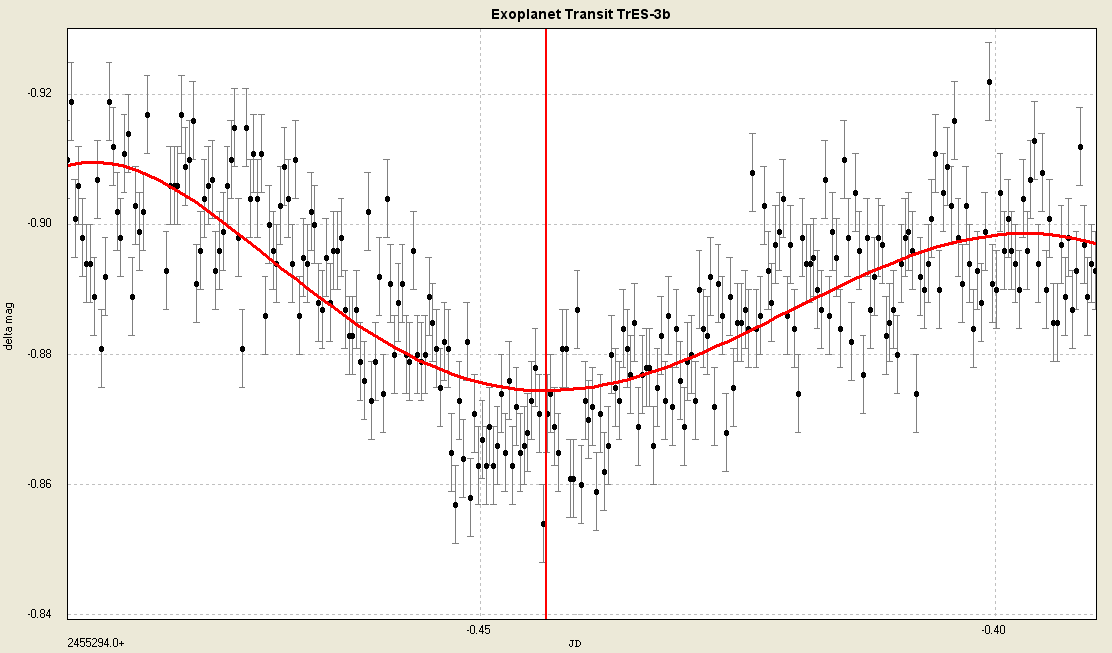
Maximum occultation at HJD 2455293.556389 ±0.0033, Value = -0.874468
Data evaluation in project TRESCA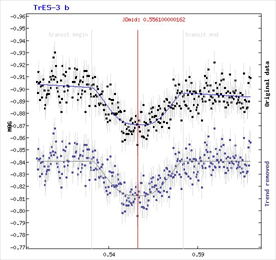
Numerical data from TRESCA project server:
JD mid: 2455293.55512 ± 0.0006
HJD mid: 2455293.55610 ± 0.0006 (helcor = 0.00098)
Mid transit - UT: 2010-04-07 01:19:22
Duration: 74.3 ± 2.9 minutes
Depth: 0.0284 ± 0.0014 mag
Planet radius: 1.275 ± 0.031 RJup
Inclination: 81.37 -0.27|1.55+0.29|1.56 °
As one can see, the event of the exoplanet transit TrES-3b was captured in useful data. Because this was my first measurement of an exoplanet transit I am hopeful to capture further exoplanet transits in other solar systems in the future.
© 2010 G. Dangl
Top of page
June 08, 2010 |
|
Site Home |